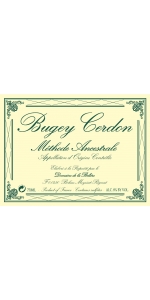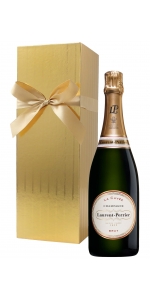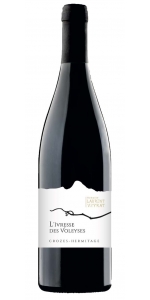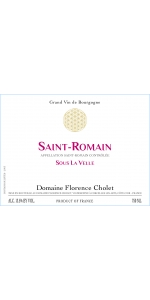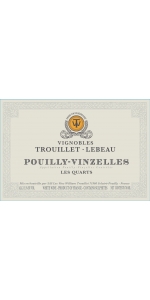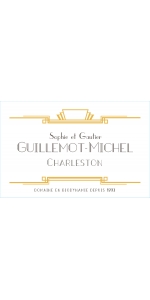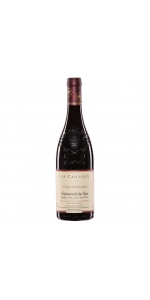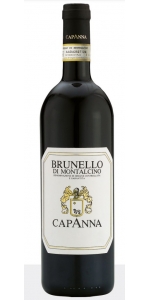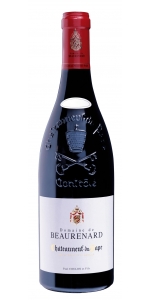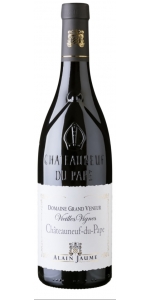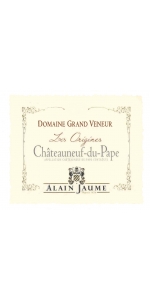Guillemot-Michel Une Bulle 2019
6 bottles with free shipping for: $300.00
12 bottles with free shipping for: $540.00
| BUY MORE! SAVE MORE! | ||||||||||||||||||||
|
| Country: | France |
| Regions: | Burgundy Maconnais |
| Winery: | Guillemot-Michel |
| Grape Type: | Chardonnay |
| Organic: | Yes |
| Vintage: | 2019 |
| Bottle Size: | 750 ml |
Guillemot-Michel Une Bulle is made from 100% Chardonnay.
This cuvée was created originally to celebrate the wedding of daughter Sophie Guillemot and Gautier!
The Chardonnay grapes come from a historic parcel of the estate - La Lie-Monin - that had been leased for nearly 30 years and that the family decided to cultivate again in 2013 following up a change of viticulture practice (towards organic) from their main neighbor.
"Bulle" is produced with the "methode ancestrale" - meaning only natural sugars are used from grapes that are harvested at optimum maturity, being less acidic and more aromatic, giving a beautiful fresh and elegant sparkling wine of crisp and juicy flavors, firm acidity and a long finish.
White meat, dessert, fruits, mild cheese, delicious on its own
Review:
"Bursting with aromas of apples, pears, almonds, warm bread and dried fruits, the 2019 Méthode Ancestrale Une Bulle is medium to full-bodied, fleshy and concentrated, with lively acids and a pillowy mousse. It's a touch drier than its 2018 counterpart. - William Kelley"
- Robert Parker's Wine Advocate (August 2021), 92 pts
The Domaine Guillemot-Michel Estate
Pierrette and Marc Guillemot took over the Domaine from Pierrette's parents in 1985. Pierrette and Marc are both oenolgists from the school of Beaune and post-graduates from Montpellier. They have applied their studies and have married both scientific and homeopathic principles in their winemaking. The Domaine is located in the commune of Quintaine, adjacent to the village of Clesse, South of Burgundy. Quintaine is recognized as producing some of the finest wines of the Mâconnais, having a special microclimate caused by the close proximity of the Saone river. The winery became biodynamic in 1991. They produce around 3,000 cases yearly and export 85% of the production (UK, USA, Belgium, Swizerland, Germany, Japan, etc)
"A tiny biodynamic estate making highly individual wines; the grapes are picked ripe, resulting in high alcohol levels and viscous textures; residual sugar not uncommon here."
- Anthony Dias Blue's pocket guide to wine 2006
The Domaine Guillemot-Michel Vineyard
This 7-hectare (17.3 acres) vineyard on a clay and limestone based soil has been cultivated through biodynamic and organic methods since 1991 (the Biodynamic method regards the earth as a living organism and strives to renew the soil in order to produce food that is full of vitality and deeply nourishing. Biodynamics notes the interrelationship of all kingdoms - mineral, plant, animal and human - and their intricate correspondence to the rhythms and activities of the larger cosmos). That means they work in harmony with the cycle of the vines and the soil. They don't use any chemicals and prefer mineral and vegetal treatments. They work the soil using manual and mechanical methods but they treat the vines only manually.
The wine is 100% Chardonnay and goes through 100% Malolactic fermentation with no use of oak. The vines average 45 years of age with a typical yield of only 2.5 tons per acre. Marc and Pierrette are constantly experimenting, searching for new ideas, willing to take on board both traditional and modern methods.
Beliere Bugey-Cerdon is made from 95% Gamay, 5% Poulsard (a local grape from Jura).
Spontaneous fermentation. An altogether preferable scenario to spontaneous combustion, and A LOT more fun to drink. This pink, semi-dry bubbly was made by spontaneous fermentation, otherwise known as methode ancestrale. Grapes are picked by hand (not just any grapes, these are the local Poulsard and Gamay grown on mountainous slopes in the shadow of the Alps), and fermented in chilled vats just reaching 5 or 6 degrees alcohol. The young and light wine is then bottled, along with its active yeast and considerable unfermented sugars. Under pressure of the cork, the wine continues to ferment, gaining a few degrees of alcohol but retaining a nice amount of sweetness. The bubbles, of course, are another result of fermentation under pressure. This one is so delicious and fun to drink, with a distinctly, well, grapy aroma and a fruitiness that calls out for celebration and jubilation.
This is also wonderful served with chocolate cake!
8% ABV.
Produced from the "Ancestral method" (also used to produce Clairette de Die): Low temperature fermentation starting in the tank, light filtration that leaves active yeast in the wine, bottling of the wine with fermentation continuing in the bottle ("spontaneous fermentation in the bottle"), retaining some sugar (40 gr/liter at the end). Made from 95% Gamay, 5% Poulsard (a local grape from Jura).
Review:
"Amber color. Aromas and flavors of cranberry juice, rose petal, cherry and kiwi, and red apple with a round, bright, effervescent, fruity medium-to-full body and a delightful, medium-long finish that shows nuances of cherry, cranberry, beeswax, and rose water. Concentrated fruit flavors, creamy bubbles, and well balanced acidity will make this a splendid pairing with charcuterie." - Beverage Testing -Institute (November 2022), 92 pts - Gold Medal
Wine Gift Set Includes:
- Laurent-Perrier La Cuvee Brut
The wine comes from the purest grape juice and it alone allows Laurent-Perrier to craft 'La Cuvée', a champagne of great finesse and a beautiful freshness obtained after a long ageing process in our cellars.Pale gold in color. Fine bubbles feed a persistent mousse. A delicate nose with hints of fresh citrus and white flowers. The wine’s complexity is expressed in successive notes like vine peach and white fruits notes. A perfect balance between freshness and delicacy with fruity flavors very present on the finish. This fresh and pure wine is perfect for an apéritif. Its citrus and white fruits notes and its remarkable balance supported by a subtle effervescence, make it an ideal accompaniment to poultry and the finest fish.
Gold Gift Box
Review:
"The brioche and cooked-apple and cream character really comes through here. Full-bodied and round with fine bubbles. Flavorful and intense. Vivid, bread-dough finish. This is four years on lees. 55% Chardonnay and the rest Pinot."
- James Suckling 93 Points
Laurent Veyrat Crozes Hermitage l'ivresse des Voleyses is made from 100% Syrah.
Review:
"Slightly more expensive, the 2020 Crozes-Hermitage L’Ivresse Des Voleyses is similarly purple-hued and has a great nose of ripe red and blue fruits interwoven with plenty of pepper, flowery incense, and spicy nuances. It’s pure, meduim-bodied, and beautifully balanced, with integrated acidity and outstanding length. It’s very much in the style of this classic, balanced vintage and is going to have over a decade of longevity."
-Jeb Dunnuck (2022), 91-93 points
"Sous la Velle" takes its name from its location 'under the village' of Saint Romain. The vineyards enjoy a steep and south facing exposure, planted on marl scree with the vines taking root in the limestone and offering a beautiful minerality to the wine. The nose expresses small red and black fruits, blackcurrant, cherry, raspberry and violet. The mouth provides a rich, supple and elegant wine with a good structure, pure fruit and vibrant acidity.
After destalking the grapes, the juice, skin and pulp are put into the vat for cold maceration. It lasts from 15 to 18 days. The alcoholic fermentation will follow, lasting from 5 to 6 days. These steps may be punctuated by push-downs. Aging in oak for 12 months.
Pork Filet Mignon, Pike Perch, Tomme de Morvan Cheese.
Trouillet Lebeau Pouilly-Vinzelles Les Quarts is made from 100 percent Chardonnay.
The wine comes from a very small parcel located in the climate of "Les Quarts" benefiting from an eastern exposure that is perfectly suited to Chardonnay, allowing early harvests and giving rich and powerful wines. Neighboring the archaeological complex of Solutré, the Vinzelles appellation is based on the same Jurassic (Bathonian and Bajocian) rocks that crown the Mâconnais mountains.
Rich aromas of peach, apricot and grapefruit, evolving with age towards fresh almond, hazelnut, honey, quince or toasted bread. This Pouilly-Vinzelles "Les Quarts" balances its natural minerality with fatness and opulence.
Guillemot-Michel Vire-Clesse Charleston is made from 100 percent Chardonnay.
This cuvée is produced from hundred-year old vines that the great-grandfather planted after he returned from World War I. The family wanted to honor his memory and vinify these vines the same way he did, in old demi-muids.
Charleston is a deep and complex wine that gently express itself in the glass, offering juicy white fruit flavors and a lengthy finish.
Charleston is vinified and aged for one year in demi-muids of over 10 years old. During the following harvest, the wine is racked and placed in vats for another 6 months of aging before bottling.
Fish in white sauce, poultry in creamy sauce, hard cheeses.
Review:
"The 2019 Viré-Clessé Charleston is brilliant, opening in the glass with notes of buttered citrus fruit, pear, beeswax and vanilla pod. Full-bodied, layered and textural, with huge concentration, lively acids and a seamless, multidimensional profile, it's long and penetrating. It's one of the very best wines I've ever tasted from the domaine. Readers will remember that the Guillemot family's oldest parcel of vines dates back to 1918, and the idea behind this cuvée is to work the vines and make the wine in the same way as their grandfather—who planted them—did. It spends a year in old demi-muids followed by six months in tank on the lees. - William Kelley"
- Robert Parker's Wine Advocate (August 2021), 94+ pts
Review:
Lastly, and a wine that will be a candidate for perfection in 4-5 years, the 2019 Châteauneuf Du Pape Centenaire reveals a deep ruby/purple hue as well as extraordinary notes of black cherries, licorice, iron, nori, and peppery garrigue. As with the base 2019, the estate did an incredible job with the tannins, and this wine is flawlessly balanced, with ultra-fine tannins, no hard edges, and the sheer class to evolve for 25+ years. This is a perfect example of power with no sensation of weight or heaviness. The blend in 2019 is 84% Grenache, 10% Mourvèdre, and 6% Syrah, and it wasn’t destemmed and was brought up mostly in concrete tanks, with just 6% in very old barrels.
-Jeb Dunnuck 98 Points
TYPE: DOCG
GRAPE VARIETY: 100% Sangiovese harvested from the oldest vineyards.
VINIFICATION: Alcoholic fermentation with maceration of the skins (25-30 days) at a controlled temperature and spontaneous malolactic fermentation, both in truncated cone-shaped Slavonian oak vats.
REFINEMENT: In Slavonian oak barrels from 10 to 32 hl for approx. 34-38 months; followed by bottle refinement of at least 6 months.
ON SALE BY:January of the 5th year after the harvest.
NOTE:
Color: intense ruby with garnet reflections.
Perfume: ethereal, of red fruit and vanilla, persistent.
Taste: harmonious, with excellent tannins and structure, very persistent.
Food pairings: roasted red meats, game, mature cheeses.
Review:
A jeweled ruby color, the 2019 Brunello Di Montalcino is forward with licorice spice on the nose and opens to notes of fresh black cherries, pine, and toasted rosemary. Medium to full-bodied, it offers wonderful energy from the start, with balanced, angular structure, ripe tannins, crunchy fresh acidity, and a long finish. Avery well styled Brunello, it will be in its prime in the coming 10-15 years.
-Jeb Dunnuck 95 Points
Aromas of redcurrants and red flowers, followed by a touch of pie crust and sandalwood. Full-bodied with steely and sturdy tannins and vivid acidity. Dried-herb character at the end. Masculine and structured. Hold until 2027.
-James Suckling 95 Points
Domaine de Beaurenard Chateauneuf-du-Pape is made from 65% Grenache, 15% Syrah, 10% Mourvèdre.
Domaine de Beaurenard’s flagship wine is a quintessential blend, reflecting all the diversity of the terroir and the perfect synergy that exists between the soils and the grapes. It offers a supple and refined texture associated with a delicate aromatic palette that is the result of a constant quest for freshness.
Review:
Checking in as a blend of 65% Grenache, 15% Syrah, 10% Mourvèdre, and the rest a handful of varieties, the 2019 Châteauneuf Du Pape was brought up in a mix of foudre and older barrels. This deep ruby/purple-hued effort has a pure, vibrant, incredibly seamless, medium to full-bodied style that carries classic notes of black raspberry and black cherry fruits as well as peppery herbs, violets, spring flowers, and sous bois. This straight-up gorgeous, seamless, ultra-fine 2019 should be snatched up by readers. It has a rare mix of elegance, purity, and power, and it’s going to have two decades of prime drinking.
-Jeb Dunnuck 95 Points
These are Magnum bottles!
Grand Veneur Chateauneuf Du Pape Vieilles Vignes is made from 50% Grenache, 40% Mourvedre, 10% Syrah
Matured in concrete vats (40%) and oak casks (60%)
It boasts an inky/purple color in addition to a gorgeous perfume of crushed rocks, jammy black fruits, charcoal and graphite. Blackberry aroma with an air of dates pressed in alongside – this is sweet-noted. It is easy to appreciate, a sleek and stylish start. The palate holds excellent fruit that runs well and has kick. Its tannins move round freely and a minted finale comes forward. Its dark fruit is tasty, darkens on the finish, where tar and char from its oak enter. It is all very much together, a bundle of harmony, and will gain local attributes as it ages.
An outstanding Chateauneuf du Pape which display the best of its terroir.
The vines are 50 to 100+ year old. They are planted on red clay soils covered with pebble stones.
Harvest is destemmed and crushed. Fermentation temperature is controlled at 30°C. Vatting period of 18 to 20 days. Matured in concrete vats (40%) and oak casks (60%).
The vineyards are located in the north of Châteauneuf du Pape. GRAND VENEUR «Vieilles Vignes» cuvee is produced from the older vines. Thanks to time and an organic growing, roots go very deep in the soil. Yields are naturally low and grapes highly concentrated.
The vines are 50 to 100+ year old. They are planted on red clay soils covered with pebble stones.
Winemaking and aging
Harvest is destemmed and crushed. Fermentation temperature is controlled at 30°C. Vatting period of 18 to 20 days. Matured in concrete vats (40%) and oak casks (60%).
Pair with venisson, duck, braised lamb or strong cheese.
Review:
"The 2019 Châteauneuf Du Pape Vieilles Vignes is based on 45% each of Grenache and Mourvèdre, with the balance Syrah, all destemmed and raised in 55% new French oak. Gorgeous cassis, violet, graphite, fruitcake, and peppery herbs define this brilliant effort, and it's full-bodied, with a pure, seamless texture, wonderful tannins, and one heck of a great finish. This magical 2019 is going to benefit from 4-5 years of bottle age (it's brilliant even today) yet keep for 20 years or more. Châteauneuf du Pape lovers need to have this in their cellar!"
- Jeb Dunnuck (November 2021),99 pts
Grand Veneur Chateauneuf-du-Pape Rouge Les Origines is made from 50% Grenache, 30% Mourvedre and 20% Syrah
Matured in vats (grenache) and in oak casks (syrah and mourvèdre).
Deep and brilliant, purple-red colour. An exciting nose with aromas of black fruit (blackcurrant, cherry) spices and vanilla. This great aromatic complexity is found on the palate : the spices and ripe fruit appear with an elegant woodiness and harmonious tannins. The finish has good aromatic length and introduces a touch of liquorice and pepper.
A terrific Châteauneuf du Pape with great concentration and finesse.
Best between 2 and 20 years. Best to decant if young (less than 5 years old).
Soil type Extreme north of Châteauneuf du Pape. This plateau is made with a high quantity of red clay mixed with rocks. This area is considerated to be one of the best to produce rich and powerful red wines. By definition, LES ORIGINES will always deliver a great complexity and ageing potential. Winemaking & ageing Harvest is sorted by hand, destemmed and crushed. Fermentation temperature is controlled at 30°C. Vatting period of 18 to 20 days. Matured in vats (grenache) and in oak casks (syrah and mourvèdre).
Review:
"The 2019 Châteauneuf Du Pape Les Origines is also deep purple-hued and has a classic bouquet of crème de cassis and blackberry fruits intermixed with notions of graphite, chocolate, and spicy wood. Rich, full-bodied, and concentrated, this is beautifully done and despite its more modern elevage, it has plenty of Provençal character and charm."
- Jeb Dunnuck (October 2020), 94-96+ pts
"Warm in feel, with a gush of plum puree and blackberry paste flavors, liberally laced with black licorice and roasted alder notes. A solidly built, modern version, with a nice tug of warm earth on the back end. Best from 2022 through 2034. —J.M."
- Wine Spectator's Insider (June 9th 2021), 93 pts
- back
Roland Champion Champagne Blanc de Blanc Grand Cru 100% chardonnay.
Champagne with rich and structured aromas. Very pleasant and generous roundness, nice length in mouth. Golden color with buttery and fruity aromas. All the expression of a magnificent terroir for your most pleasurable moments.
Manual harvest; then pressing immediately to avoid oxidation & preserve quality. Free run juice only. Aged six years sur lattes.
It matches magnificently with foie gras!
This 100% Cortese white offers fruity aromas intertwined with hints of daisy and acacia flowers. Fresh and elegant on the palate with charming citrus notes.



